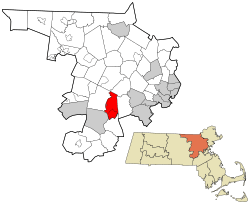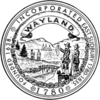Wayland, Massachusetts facts for kids
Quick facts for kids
Wayland, Massachusetts
|
||
|---|---|---|

First Parish in Wayland
|
||
|
||

Location in Middlesex County in Massachusetts
|
||
| Country | United States | |
| State | Massachusetts | |
| County | Middlesex | |
| Settled | 1638 | |
| Incorporated | 1780 | |
| Government | ||
| • Type | Open town meeting | |
| Area | ||
| • Total | 15.9 sq mi (41.2 km2) | |
| • Land | 15.2 sq mi (39.4 km2) | |
| • Water | 0.7 sq mi (1.7 km2) | |
| Elevation | 127 ft (39 m) | |
| Population
(2020)
|
||
| • Total | 13,943 | |
| • Density | 876.9/sq mi (338.4/km2) | |
| Time zone | UTC-5 (Eastern) | |
| • Summer (DST) | UTC-4 (Eastern) | |
| ZIP Code |
01778
|
|
| Area code(s) | 508/774 | |
| FIPS code | 25-73790 | |
| GNIS feature ID | 0618243 | |
| Website | http://www.wayland.ma.us/ | |
Wayland is a town in Massachusetts, United States. It is located in Middlesex County. The town was first settled in 1638. It officially became a town in 1780. Wayland was originally part of a larger area called Sudbury. In 2020, about 13,943 people lived in Wayland.
Contents
History of Wayland
Wayland started as the first settlement of a larger area called Sudbury Plantation in 1638. Later, in 1722, the people living in what is now Sudbury formed their own western part. Those in Wayland became the eastern part.
Before the American Revolution, Sudbury had a large group of citizen soldiers called a militia. About 400 men were part of it. When the Battles of Lexington and Concord happened on April 19, 1775, over 300 of these soldiers marched to Concord. About 115 of them were from the Wayland area.
Becoming the Town of East Sudbury
The area known as East Sudbury officially became its own town on April 10, 1780. The people living on the eastern side of the river, including Pelham Island, were generally wealthier. This meant they paid more than half of the town's taxes. This was true even though more than half of the population lived on the western side.
Renaming to Wayland
On March 11, 1835, the town decided to change its name from East Sudbury to "Wayland." This was done to honor Dr. Francis Wayland. He was a strong supporter of the temperance movement (which encouraged people to drink less alcohol). He also worked to end slavery (abolitionist). At the time, he was the president of Brown University. Dr. Wayland was a friend of local Judge Edward Mellen.
Both Dr. Wayland and Judge Mellen strongly believed in public libraries. They gave money to help start a public library for the town. There were questions about whether it was legal to use taxes to create a library. Representative Reverend John Burt Wight took this question to the state government. This led to a Massachusetts state law in 1851. This law made it possible to create free public libraries. Because of this, the Wayland Public Library is thought to be the first free public library in Massachusetts. It was also the second public library in the entire country. The building where the library is now was built in 1900.
Famous People and Events
In the mid-1800s, Wayland was home to several famous people. One was Rev. Edmund Sears, an abolitionist and minister. He wrote the famous 1849 poem and song "It Came Upon the Midnight Clear." Another was Lydia Maria Child, an abolitionist, author, and supporter of women's right to vote (suffragist).
The Sudbury Valley Trustees is a group that works to protect natural lands. It was started in 1953 by seven men from Wayland.
In 2010, after very heavy rains, parts of Wayland, like Pelham Island, became flooded. Special Boston Duck Tours vehicles were used to help transport people in and out of their homes until the water went down.
The Wayland display server protocol, a type of computer software, is named after the town.
Geography and Location
Wayland covers an area of about 15.9 square miles (41.2 square kilometers). About 15.2 square miles (39.4 square kilometers) of this is land. The remaining 0.7 square miles (1.7 square kilometers), or about 4.21%, is water.
Wayland shares its borders with several other towns. These include Lincoln, Sudbury, Weston, Framingham, and Natick. It also has a small border with Concord.
Population and People
| Historical population | ||
|---|---|---|
| Year | Pop. | ±% |
| 1850 | 1,115 | — |
| 1860 | 1,188 | +6.5% |
| 1870 | 1,240 | +4.4% |
| 1880 | 1,962 | +58.2% |
| 1890 | 2,060 | +5.0% |
| 1900 | 2,303 | +11.8% |
| 1910 | 2,206 | −4.2% |
| 1920 | 1,935 | −12.3% |
| 1930 | 2,937 | +51.8% |
| 1940 | 3,505 | +19.3% |
| 1950 | 4,407 | +25.7% |
| 1960 | 10,444 | +137.0% |
| 1970 | 13,461 | +28.9% |
| 1980 | 12,170 | −9.6% |
| 1990 | 11,874 | −2.4% |
| 2000 | 13,100 | +10.3% |
| 2010 | 13,444 | +2.6% |
| 2020 | 13,943 | +3.7% |
| 2022* | 13,664 | −2.0% |
| * = population estimate. Source: United States Census records and Population Estimates Program data. |
||
In 2010, there were 13,444 people living in Wayland. There were 4,808 households and 3,676 families. The town had about 859.9 people per square mile.
Most of the people in Wayland were White (87.2%). About 9.9% were Asian. A smaller number were African American (0.9%) or from other backgrounds. About 2.4% of the population was Hispanic or Latino.
In 2000, about 41.4% of households had children under 18 living with them. Most households (71.5%) were married couples. The average household had 2.80 people. The average family had 3.15 people.
The median age in Wayland was 41 years old. About 28.7% of the population was under 18. About 14.3% were 65 years or older.
The median income for a household in Wayland was $121,036. For a family, the median income was $204,033.47. The average income per person was $75,144. About 2.5% of the population lived below the poverty line.
Education in Wayland
The town of Wayland has six public schools:
- The Children's Way (Pre-Kindergarten)
- Claypit Hill Elementary School (Kindergarten–Grade 5)
- Happy Hollow Elementary School (Kindergarten–Grade 5)
- Loker Elementary School (Kindergarten–Grade 5)
- Wayland Middle School (Grades 6–8)
- Wayland High School (Grades 9–12)
There is also one private school in Wayland called Veritas Christian Academy (Kindergarten–Grade 8).
Notable People from Wayland
Wayland has been home to many interesting people.
Musicians
- Sammy Adams, a rapper.
- Tom Hamilton, the bass player for the famous rock band Aerosmith.
- Daniel Lopatin, an experimental musician known as Oneohtrix Point Never.
- Peter Rowan, a bluegrass musician.
- Tom Scholz, the guitarist for the 1970s rock group Boston.
- Steven Tyler, another member of Aerosmith. He held the first and only rock concert in the Wayland High School field house before the band became world-famous.
Business Leaders
- Andrew Bachman, an entrepreneur and investor.
- Joshua Bekenstein, co-chairman of Bain Capital.
- Amar Bose, who founded Bose Corporation, a company known for high-quality sound systems.
- George Howell, who started George Howell coffee.
Athletes
- Ricky Davis, an NBA basketball player.
- Ted Johnson, an NFL football player.
- Thomas Kiefer, a rower who competed in the 1984 Summer Olympics.
- Walter McCarty, an NBA player and coach.
- Jonathan Papelbon, an MLB baseball player.
- Alberto Salazar, a distance runner and athletics coach.
- Dwight Schofield, a professional hockey player.
- Ted Williams, a Baseball Hall of Famer, who lived on Dudley Pond.
Actors and Actresses
- Beatrice Herford, an actress.
- Liza Huber, an actress from the TV show Passions.
- Taylor Schilling, an actress known for the TV series Mercy and Orange is the New Black.
- Ryan Sypek, an actor from the TV series Wildfire.
Other Notable Residents
- Lydia Maria Child, a 19th-century abolitionist, novelist, and journalist. She wrote "Over the River and Through the Wood."
- Glenn Cooper, a best-selling thriller writer and film producer.
- Archibald Cox, a legal expert who was the Special Prosecutor during the Watergate Scandal.
- David Hackett Fischer, a history professor and author.
- Sarah Hurwitz, who was Michelle Obama's speech writer.
- Joyce Kulhawik, an arts and entertainment anchor for WBZ-TV News in Boston.
- Johnny Most, the radio voice of the Boston Celtics basketball team.
- Samuel Parris, a reverend and magistrate during the Salem Witch Trials. He is buried in Wayland.
- Jerry Remy, a former Boston Red Sox player and TV announcer.
- Harold Russell, an Academy Award winner for his role in the 1946 movie The Best Years of Our Lives.
- Edmund Sears, a minister who wrote the words to "It Came Upon the Midnight Clear."
- Mary Sears, an Oceanographer.
- Gladys Widdiss, a tribal historian and potter.
See also
 In Spanish: Wayland (Massachusetts) para niños
In Spanish: Wayland (Massachusetts) para niños



